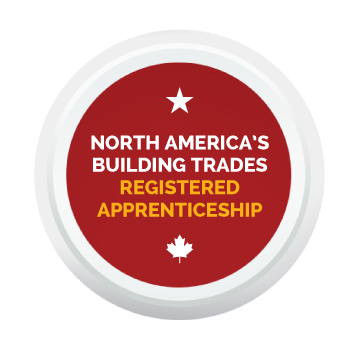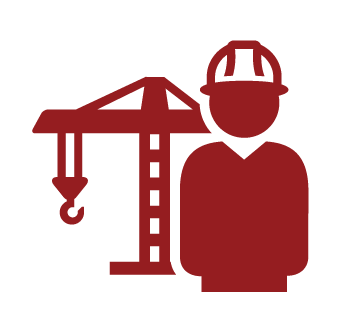Apprenticeship Readiness Programs (ARPs)
PREPARING FOR THE BUILDING TRADES
NABTU is proud to support the American School Counselor Association. Congratulations to 2023 School Counselor of the Year, Meredith Draughn!
North America’s Building Trades Unions (NABTU) sponsors comprehensive apprenticeship readiness programs (ARPs) throughout the U.S. These programs provide a gateway for local residents – focusing on women, people of color, and transitioning veterans – to gain access to Building Trades’ registered apprenticeship programs. ARPs are administered by state and local Building Trades Councils and they teach NABTU’s nationally recognized Multi-Craft Core Curriculum (MC3).
Construction Math Lab
Every time a construction worker steps on a jobsite, they use math skills. Construction is really applied math. All buildings, roads, tunnels, bridges and other structures are the result of mathematical principles applied to architecture and construction. Ever since humans first started to live and work in human-created “buildings,” the people who designed and built these structures have used mathematical principles to make sure these structures looked nice, functioned properly and achieved their desired purpose.
Even in our modern, technological society, construction workers still measure, add, subtract, divide, multiply, and work with fractions every day – although today they may use a calculator or iPad. Workers in all Trades measure length, width, depth, area and volume. How much concrete will they need to put a floor in a factory? How much weight in cars, trucks and cargo will a bridge need to bear? What is the proper angle for a roof, in an area that gets a lot of snow? How much paint will they need to paint the school? Every aspect of construction requires a good working knowledge of math and measurement.
Construction careers in the union Building Trades are good jobs, with middle class pay and benefits, so it makes sense that if you want one of these lucrative careers, that you should come prepared with good construction math skills.
This is the purpose behind Construction Math Lab. On this webpage, NABTU provides you with self-paced, no-cost resources to help you improve your construction math skills. The exercises, videos and math problems located here are designed to challenge you and expand your working knowledge of construction math, so you can successfully enroll in a NABTU Apprenticeship Readiness Program or directly in a Building Trades Registered Apprenticeship Program. Both are pathways to great careers in the union construction industry.
Completion of Construction Math Lab lessons does not guarantee that you will pass a particular Building Trades Training Center’s aptitude test or guarantee admission into an Apprenticeship Readiness Program or Building Trades Registered Apprenticeship Program. The lessons are simply a tool to help you improve your construction math skills.
APPRENTICESHIP READINESS GOALS:


Bringing Construction Trades Classes Back to the Schools
Certified by a number of State Education Departments, NABTU’s MC3 is bringing true construction education back into high schools. NABTU knows the importance of introducing, connecting and engaging young people early to harness a lifetime dedication to our trades.
WE INTRODUCE: NABTU’s MC3 introduces students to the different building trades and teaches them the skills necessary to successfully apply for a registered apprenticeship, debt-free education.
WE CONNECT: NABTU’s MC3 connects two high-quality education systems: America’s secondary schools and the Building Trades registered apprenticeship programs.
WE ENGAGE: NABTU’s MC3 engages students with industry and labor leaders through state-of-the-art curriculum.
Trades for Tomorrow: NABTU's Multi-Craft Core Curriculum (MC3)
Building Trades ARPs teach the Multi-Craft Core Curriculum (MC3), a standardized, comprehensive, 120-hour construction course designed to help young people and transitioning adults choose and succeed in apprenticeship programs that are appropriate for them.
The MC3 curriculum is taught face-to-face, but it is delivered via NABTU’s Online Learning Management System.
SCHOOL COUNSELOR & TEACHER RESOURCES
NABTU’s world-class apprenticeship and training system provides eager students with an opportunity to earn a competitive salary and benefits. Participants receive state-of-the-art, technologically advanced, industry-sanctioned training from the construction industry’s highest trained instructors and leave with invaluable skills to set your students up for success. With the concept of “Earn-while-you-learn,” your students earn money while receiving college credit towards their degree.
- NABTU 2020 Recruitment Video
- NABTU ARP Q&A
- IMPLEMENTING THE BUILDING TRADES’ MC3: A GUIDE FOR YOUTHBUILD PROGRAMS (Adobe Flash 13.0 Needed)
- MC3 IN OUR SCHOOLS: A GUIDE FOR CTE TEACHERS, ADMINS, AND SCHOOL COUNSELORS PPT
- NABTU APPRENTICESHIP BROCHURE
- NABTU Apprenticeship Brochure (Spanish)
- ENCOURAGING CA YOUTH TO THE TRADES - HINES
- YOUNG INVINCIBLES APPRENTICESHIP REPORT
- WHY TEACH THE MC3 IN SCHOOLS
- ARP and Apprenticeship Entrance Requirements
- Find an MC3 Program
- Exploring Construction for Middle School Students
- Exploring Construction for Elementary School Students
- FAQ for MC3 in the Schools
- Apprenticeship vs. College Infographic
- Trailblazer Award









